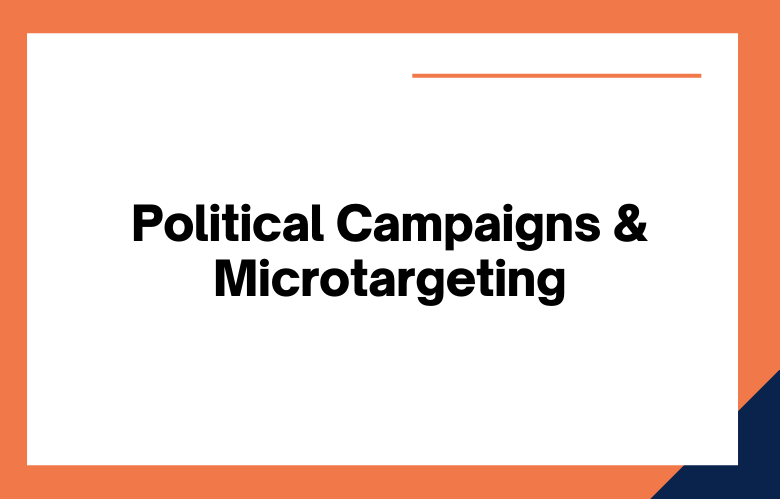Campaigns have been using microtargeting to win elections for years. But what is micro-targeting, and why is it so important? Microtargeting targets specific voters with tailored messages based on their demographics, political opinions, and other factors.
It grants campaigns to focus their resources on the voters most likely to support them, which is the difference between winning and losing.
We’ll look at microtargeting and see how political campaigns use it.
We’ll also discuss its pros and cons and explore some of the criticisms that have been leveled against it if you want to learn more about this fascinating topic.
Microtargeting is a term used in marketing and political campaigns that refers to technology to target specific individuals or groups with advertisements or content.
This type of advertising has become increasingly popular in recent years, as digital technologies have allowed it to collect and analyze large amounts of data about individual voters.
Campaigns can use this information to design targeted messages more likely to appeal to specific voters.
While microtargeting has benefits, some risks also need to be considered.
What is Microtargeting?
Microtargeting is a marketing strategy that uses detailed demographic data to target specific groups of consumers with tailored ads and messages.
This strategy reaches people of specific ages, genders, income levels, and interests.
Microtargeting can be an effective way to reach potential customers and convert them into sales.
Microtargeting is a relatively new marketing technique targeting explicitly tiny consumer groups. By tailoring advertisements and messages to fit the specific characteristics of these small groups, businesses, and organizations hope to reach their target customers more effectively.
Microtargeting is used by political campaigns to identify and target potential voters. This technique uses data about voters, such as demographics, interests, and voting history, to target them with personalized messages.
Microtargeting can be an effective way to win over support from a broader range of voters. In particular, it can help reach out to undecided or swing voters. It can also help campaigns better understand essential issues for specific groups of people.
Micro-targeting in Political Campaigns
Micro-targeting has become a widespread technique in political campaigns. It involves using data to target small groups of voters with customized messages.
The aim is to use information about people’s interests, demographics, and preferences to create targeted messages that resonate with them.
This approach can effectively persuade people to vote for a particular candidate or party.
Micro-targeting in political campaigns can be a very effective way to reach voters. By targeting specific groups of people, campaigns can hone their message and better appeal to their desired demographic. It targets advertising, a great way to get your message out there and win candidate support.
Micro-targeting is a technique that political campaigns use to target small groups of voters with narrowly tailored messages.
This technique involves data about voters, such as their voting history, demographics, and interests, to segment them into small groups.
Once these groups identify, the campaign can tailor its message to appeal to each group’s interests.
This technique can effectively win over close races where every vote counts.
Best practices for using micro-targeting in political campaigns
Best practices in political campaign microtargeting can make a big difference in the outcome of elections. By using data to target potential voters with tailored messages, campaigns can reach their desired audience more effectively. This technique uses a significant effect on both local and national races.
Micro-targeting is a common practice in political campaigns. By segmenting voters by specific characteristics, campaigns can more effectively target their message and persuade more voters to support their candidate. However, micro-targeting can also have negative consequences, such as further alienating groups of voters who may feel targeted by campaign messages that are not relevant to them.
Micro-targeting in political campaigns can be a great way to get your message to the right people. However, you must ensure that you’re using this tool correctly.
For example, you don’t want to target people with ads that are entirely irrelevant to them. That’s a surefire way to turn people off and lose their support.
Instead, focus on targeting people with ads specific to their interests and needs. It ensures that your message resonates with them and that they’re more likely to support your campaign.
Micro-targeting has become a mainstay of political campaigns. But, as with any tool, there are right and wrong ways to use it. Here are some best practices for micro-targeting in political campaigns.
Micro-targeting has become a popular way for political campaigns to narrow their focus and tailor their message to specific groups of voters. But not all campaign professionals think this is a good idea. Some believe that micro-targeting can backfire, resulting in a narrower and less effective message.
Micro-targeting is a common practice in political campaigns. By using data and analytics, campaigns can target specific groups of voters with personalized messages. It helps the drive allocate resources better and focus on key groups of voters.
Micro-targeting can be a powerful tool for political campaigns, but it’s essential to use it wisely.
Understand your target audience. Who is your audience to reach, and what there care about?
Develop targeted messages. What kind of content will resonate with your audience?
Target specific channels. Where do your target voters consume information? Which platforms are the most active?
Test, measure, and adjust. Try different approaches and see what works best for your campaign.
Microtargeting has become a best practice in political campaigning. By segmenting voters based on their interests using data analysis, campaigns can more efficiently target specific messaging to critical demographics.
This technique has been used effectively by both Democratic and Republican campaigns and plays between smaller and larger movements.
While microtargeting can effectively reach voters, it is essential to remember that not all constituents will respond positively to this personalized message. In some cases, it is invasive or even creepy.
Campaigns need to walk a fine line when using microtargeting techniques and tread carefully to avoid turning potential supporters.
Conclusion
Microtargeting is becoming a more important factor in political campaigns.
As technology develops, we will see more ways to target voters and get our message out.
Contact us today to learn about the microtargeting that benefits your campaign or needs help implementing these techniques.
We have years of experience helping candidates win elections through cutting-edge campaigning methods like microtargeting.
Microtargeting: Micro-targeting in Political Campaigns – FAQs
What Is Microtargeting in Political Campaigns?
Microtargeting is a data-driven strategy that delivers personalized political messages to specific voter segments based on demographic, behavioral, and psychographic data.
Why Do Political Campaigns Use Microtargeting?
It allows campaigns to reach the right voters with the right message at the right time, improving persuasion, engagement, and turnout.
What Kind of Data Powers Political Microtargeting?
Microtargeting uses voter registration data, consumer data, social media activity, survey responses, and behavioral insights.
How Does Microtargeting Differ from Traditional Targeting?
Traditional targeting focuses on broad groups like age or region, while microtargeting drills down into granular attributes like lifestyle, interests, and issue positions.
What Are Some Common Use Cases of Microtargeting in Campaigns?
It’s used for issue-based messaging, fundraising appeals, voter mobilization, persuasion ads, volunteer recruitment, and event promotion.
Which Platforms Are Most Effective for Political Microtargeting?
Platforms like Facebook, Instagram, Google Ads, YouTube, programmatic display networks, and email marketing systems support effective microtargeting.
What Is Psychographic Profiling in Microtargeting?
Psychographic profiling segments voters based on personality, values, attitudes, and emotional triggers to tailor more persuasive messaging.
How Does Microtargeting Influence Voter Behavior?
By aligning messages with individual concerns or motivations, microtargeting increases message relevance and likelihood of voter action.
Can Microtargeting Be Used for Negative Campaigning?
Yes, campaigns sometimes use microtargeting to deliver attack ads to specific groups without wider public visibility, raising ethical concerns.
What Are the Ethical Concerns Around Microtargeting?
Concerns include manipulation, privacy invasion, lack of transparency, voter profiling, and the spread of misleading or divisive content.
Is Microtargeting Legal in All Countries?
Legal status varies by country. While it’s widely used in the US, regulations like GDPR in Europe limit the extent of microtargeting based on personal data.
How Can Campaigns Ensure Ethical Use of Microtargeting?
By being transparent, avoiding manipulation, securing consent for data use, and ensuring fairness and truth in messaging.
What Role Does AI Play in Political Microtargeting?
AI enhances microtargeting by analyzing massive datasets, predicting behavior, optimizing message delivery, and automating segmentation.
How Do Campaigns Create Microtargeting Personas?
They use data analytics to build detailed voter profiles based on age, income, beliefs, behaviors, and political history.
How Is Microtargeting Measured for Effectiveness?
Effectiveness is tracked through engagement metrics, conversion rates, voter turnout, and post-campaign attribution studies.
Can Microtargeting Help in Local and Down-Ballot Elections?
Yes, it enables hyper-local campaigns to reach niche voter groups with customized messaging even on limited budgets.
What Is the Role of Lookalike Audiences in Microtargeting?
Lookalike audiences are groups that resemble a campaign’s existing supporter base, enabling campaigns to scale outreach to similar voters.
How Does Microtargeting Impact Political Polarization?
Critics argue it can deepen polarization by creating echo chambers and delivering narrowly framed messages to segmented audiences.
What Safeguards Can Be Put in Place for Responsible Microtargeting?
Campaigns can adopt data transparency policies, ethical guidelines, oversight mechanisms, and public reporting on targeting practices.
What Tools Are Commonly Used for Political Microtargeting?
Tools include NationBuilder, Civis Analytics, Facebook Ads Manager, Google DV360, data management platforms, and custom-built CRM systems.
One way to get in touch is by filling out our online form on this site or give us a call at
+91 9848321284. Let’s work together today!











